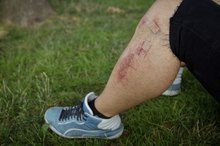What does fact checked mean?
At Healthfully, we strive to deliver objective content that is accurate and up-to-date. Our team periodically reviews articles in order to ensure content quality. The sources cited below consist of evidence from peer-reviewed journals, prominent medical organizations, academic associations, and government data.
The information contained on this site is for informational purposes only, and should not be used as a substitute for the advice of a professional health care provider. Please check with the appropriate physician regarding health questions and concerns. Although we strive to deliver accurate and up-to-date information, no guarantee to that effect is made.
Signs of Infection From Stepping on a Nail
Stepping on a nail can cause a painful wound on the bottom of your foot. Worse yet, puncture wounds such as those caused by a nail can cause an infection if not properly cared for. You'll also need to receive a tetanus shot if you have not had a booster in the past 12 years, according to the University of Michigan Health System. If you do step on a nail, monitor the wound for signs of infection. If you do develop an infection, visit your doctor for antibiotics to prevent it from spreading.
If you are experiencing serious medical symptoms, seek emergency treatment immediately.
Pus
When a puncture wound caused by a nail becomes infected, you may notice pus or other drainage leaking or seeping from the wound, according to the Lucile Packard Children's Hospital at Stanford. The seeping fluid can be cloudy or yellowish in appearance.
Red Streaks
What to Do for a Ripped-Loose Fingernail?
Learn More
A skin infection caused by a puncture wound can cause red streaks to appear around the wound. The skin immediately surrounding the puncture wound may also appear red and may feel warm to the touch, reports MedlinePlus, a service of the U.S. National Library of Medicine 1.
Pain and Tenderness
Skin infections can cause pain and tenderness at the infection site. In particular, you may notice that the skin around the wound becomes more swollen and tender about two days after you step on the nail, according to the Lucile Packard Children's Hospital.
Fever
Infected Toe Treatment
Learn More
As with other infections, a wound infection can also cause a fever. If you develop a fever and do not have any other signs of common infections causing a fever, it may be because of your wound, according to the University of Michigan Health System. The fever may occur either with or without chills.
Swollen Lymph Nodes
As with other infections, a wound infection may cause lymph nodes to swell. Lymph nodes are found throughout the body, but they are easiest to palpitate in the neck and armpits. Swollen lymph nodes often develop in conjunction with a fever.
- As with other infections, a wound infection may cause lymph nodes to swell.
- Lymph nodes are found throughout the body, but they are easiest to palpitate in the neck and armpits.
Related Articles
References
- MedlinePlus: Cuts and Puncture Wounds
- Mayo Clinic: Puncture Wounds: First Aid
- U.S. National Library of Medicine. MedlinePlus. Cuts and Puncture Wounds. Updated 01/12/15. https://medlineplus.gov/ency/article/000043.htm
- Kasper, Dennis L.., Anthony S. Fauci, and Stephen L.. Hauser. Harrison's Principles of Internal Medicine. New York: Mc Graw Hill education, 2015. Print.
- U.S. National Library of Medicine. MedlinePlus. Cuts and Puncture Wounds. Updated 01/12/15.
Writer Bio
Anna Aronson began working as a journalist in 2000 and spent six years at suburban Chicago newspapers before pursuing freelance work. She enjoys writing about health care topics, in particular obstetrics, pediatrics and nutrition. She received a Bachelor of Arts in journalism from Eastern Illinois University and is now studying for a Master of Science in medicine degree to become a physician's assistant.








